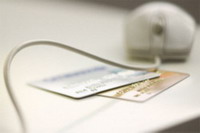Internet click fraud occurs far more frequently
Deceptive clicks on Internet advertising links sent by Google Inc., Yahoo Inc. and other online marketing vehicles are probably occurring far more frequently than the network operators acknowledge.

The chicanery involves automated computer programs or scam artists who repeatedly click on ad links with no intention of buying anything. The short ad links, which appear alongside search results and other content at thousands of Web sites, typically trigger a commission with each click - a financial formula ripe for mischief, Minneapolis-based Fair Isaac found.
The study's preliminary conclusions, scheduled to be discussed Friday during a Fair Isaac conference in San Francisco, threaten to revive suspicions among advertisers that they have been overcharged as part of a ruse known as "click fraud."
After reviewing a handful of Web sites since last August, Fair Isaac believes 10 to 15 percent of the advertising traffic is "pathological," indicating a likelihood of click fraud, said Joseph Milana, the company's chief scientist of research and development.
"It's still an early result," Milana said. "The question remains about how broad the problem is in the entire marketplace."
The culprits behind click fraud typically are either trying to make more money from the ads appearing on their own Web sites or maliciously trying to drain the marketing budgets of a competitor.
Google, which runs the Internet's largest ad network, maintains its engineers and filters identify all but 0.02 percent of the click fraud on its network. The Mountain View-based company says it doesn't bill advertisers for any of the flagged click fraud.
Yahoo, which runs the second-largest ad network, also maintains its preventive measures weed out all but a small portion of click fraud.
Fair Isaac's initial estimates fall in the same range as those made by Click Forensics, a San Antonio-based consulting service that compiles a quarterly index tracking click fraud rates.
Other studies have estimated click fraud rates as high as 30 percent, a figure implying advertisers have paid billions of dollars for bogus sales referrals during the past few years.
Google and Yahoo have consistently ridiculed double-digit click fraud estimates as the handiwork of search engine consultants trying to drum up more demand for their services by alarming advertisers.
On the flip side, Google and Yahoo have a powerful incentive to debunk the click fraud claims to preserve confidence in a system that generates most of their profits. Last year alone, Google and Yahoo sold a combined $16 billion (11.8 billion EUR) in Internet ads.
Fair Isaac enters the debate with a track record for ferreting out fraudulent conduct in other industries.
Best known for a scoring system that rates the creditworthiness of consumers, Fair Isaac also has helped banks fight credit card fraud for 15 years. More recently, the company has sold anti-fraud tools to health care providers and telecommunications companies.
Now, Fair Isaac is trying to determine whether click fraud is a big enough problem to justify the company developing a potential solution that could help boost its own profits. "This is a problem that fits well in our sweet spot," Milana said.
Click fraud doesn't appear to be a major problem when the ads appear on Google's and Yahoo's respective Web sites, Milana said.
The trouble starts cropping up once Google and Yahoo deliver the ads to other Web sites that are part of their vast marketing networks.
"They just don't know what happens beyond their own firewalls," Milana said of Google and Yahoo.
Ads on other Web sites accounted for $4.16 billion (3.08 billion EUR), or 39 percent, of Google's revenue last year. Google shared $3.31 billion (2.45 billion EUR) of that revenue with its advertising partners. Yahoo doesn't break out how much of its revenue comes from ads on other Web sites.
Subscribe to Pravda.Ru Telegram channel, Facebook, RSS!


